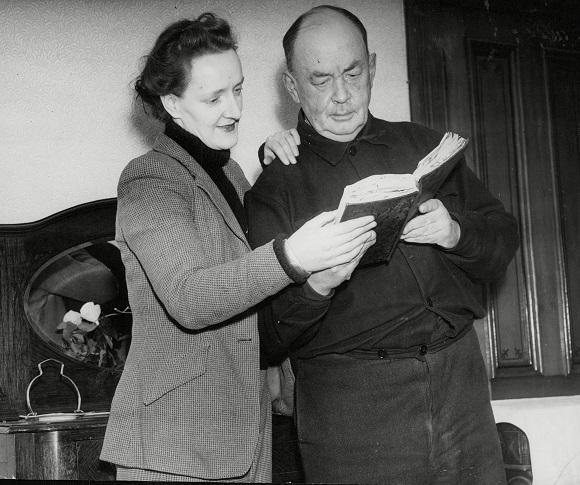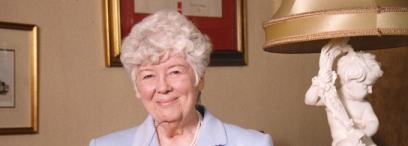In the year 1948 there were 43,747 marriages registered in Scotland. These records have now been made available to search, view and save on ScotlandsPeople alongside the release of births from 1923 and deaths from 1973. The Registrar General’s Report of 1948 stated that the months of March, June, July and September were most popular for marriage. There were fewer marriages registered than the previous year, in which 44,144 marriages were undertaken.
To mark this record release we have examined a particularly intriguing marriage from that year. Few of the marriages that took place in 1948 can be as captivating as that between Col. Victor Konstantine Kaledin and Louise Drube. The ceremony took place on 1 June at Ladybank in the district of Collessie, Fife. Kaledin, who also used the name Victor Konstantine Cecil Luke de Mordowtzeff, is recorded as ‘Author’ on the certificate, however, this description, while not inaccurate, masks a much more colourful past.
Marriage certificate of Victor Kaledin and Nellie Edith Louise Malpass or Wanickiet. The ceremony took place at Ladybank, Fife on 1 June 1948.
Crown copyright, National Records of Scotland, Statutory Register of Marriages, 1948, 416/2
Victor Kaledin was born on 31 August 1887 at Rostov-on-Don, Russia, into a prominent military family. As a child Kaledin was allegedly a member of the Royal Russian Court as first page to Tsar Nicholas II. During World War One Kaledin obtained a post with the OGPU (initial Russian letters for ‘United State Political Administration’): Russia’s secret police. The OGPU posted Kaledin to Berlin with the code name K.14. A gifted linguist, Kaledin claimed to speak 14 languages. He wasted no time in putting his language skills to good use and promptly became a double agent for German intelligence as agent O.M.66. Kaledin also claimed to have spied for the Italian and British secret services. (Western Times, 18 May 1934)
Given he had been in the employ of both German and Tsarist Russian secret services, Kaledin feared for his personal safety in the aftermath of World War One and he appears to have spent the immediate postwar period drifting around the globe, visiting Indonesia, South Africa and the United States of America. Kaledin made the US his permanent home in 1923, becoming an American citizen in 1924. Like so many prominent figures connected to the Tsarist regime he found himself living in reduced circumstances, taking a succession of odd jobs in order to support himself and his Polish-born first wife Maria Emilia de Mordowtzeff (1930 census of Goshen, Orange, New York, U.S.A). The fate of his first wife is unknown, but it is presumed that they were divorced or that Maria died during 1930, allowing Kaledin to remarry.
Shortly after his appearance in the American 1930 census records, he travelled to Southampton, England and in the same year married his second wife, Evelyn Mary Ferneley (1875-1946). He became a naturalised British subject some years later. Kaledin and Fernley lived quietly in a Devon cottage for a number of years, with Kaledin attempting to make a living as an author of espionage novels, including a semi-autobiographical account of his time as a double agent, using his former aliases ‘K.14 – O.M.66’ for its title.
Increasingly, Kaledin began to report a series of attempts on his life, claiming that his former enemies had caught up with him. However, for a man seemingly in fear of his life, he courted a remarkable degree of publicity. In a newspaper interview with the Weekly Dispatch of 22 October 1933 he divulges that he and his wife were “living all the time on the brink of death”. Whether this was a genuine fear or an attempt to drum up publicity for his career as an espionage novelist is unclear. Certainly his would-be assassins seemed remarkably inept or unlucky: Kaledin reported that one night while closing his bedroom shutters a bullet was fired through the shutter and into the bedroom wall. Another fantastical close encounter came when he was walking down a “lane that approaches the cottage when a revolver blazed from the hill above. I felt a thud, and my hat fell to the ground. When I picked it up I discovered a bullet hole straight through the crown.”
Either way, Kaledin’s espionage novels did not prove to be either a critical or commercial success. It appears that Kaledin did not make a good living from his literary works as, after Evelyn’s death in 1948, he was reported as living in a West Devon cave and eating boiled seaweed for nourishment (West Morning Star, 3 February 1948).
Kaledin would not remain in his Devon cave for long and relocated to Scotland. After a whirlwind courtship he married Louise Drube, a commercial artist in June 1948. Drube, like her second husband, had an alias. Born Nellie Edith Louise Malpass in Fulham, London in 1908, Louise Drube married her first husband, Propart Wanickiet from Siam (now Thailand) in Hammersmith in 1935. She worked as a commercial artist, later specialising in creating dress-up dolls for children and teenagers. Louise Drube Kaledin published her creations using the title Her Serene Highness Princess Razibor (or simply ‘Razibor’) after her marriage to Kaledin. The title was allegedly passed down through the female line of Victor Kaledin’s maternal family and, as he rather fancifully explained, was reputedly a ‘gift from James III of Scotland’ (Daily Mirror, 25 January 1962).
During the 1950s Kaledin adopted a new career, offering his services as a ‘Psychic Consultant’. Initially living in Pitt Street in Leith, it would appear something of a comedown for a man who had spent his early childhood in the court of Tsarist Russia. However, by 1954 the couple’s fortunes had improved so sufficiently that they were living in a handsome town house at 27 Ann Street in the now fashionable area of Stockbridge in Edinburgh (Edinburgh Evening News, 2 October 1954).

Photograph entitled ‘Col. Victor Kaledin Who Was One Of The Richest Noblemen In The Czar's Russia And His Wife H.s.h. Louise Princess Razibor. They Now Live In Edinburgh In Poverty’, no date.
Image credit: ANL/Shutterstock
Like much in Kaledin’s life, his time in Scotland would not last. Along with his third wife, Kaledin left Scotland for Denmark, before relocating to Majorca in 1961. At the time of his move to the Spanish island, Kaledin would have been 74 years old and his wife 53. After a colourful life, shrouded in mystery, shifts of fortune and improbable tales of daring feats, the trail runs cold in Majorca, where we can only speculate whether he lived out his life in peaceful retirement or that his alleged enemies had caught up with the ex-Russian spy and former Edinburgh resident.
For further details about the Statutory Register of Marriages please see our online guide.


